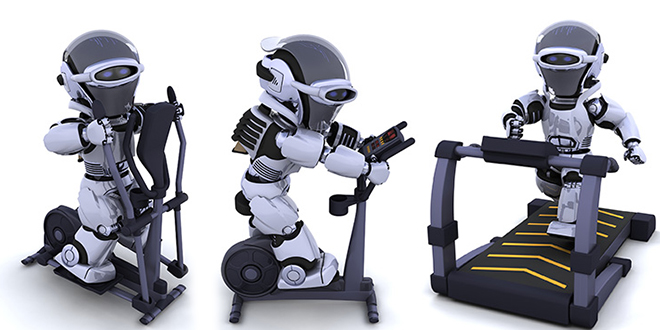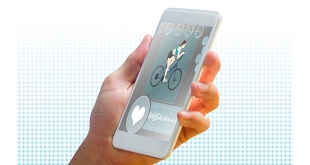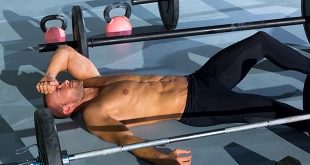As you probably know, whatever your fitness or weight loss goals are, if you want to get the best results, you should incorporate both cardio and strength training into your workout routines.
That’s why is important to have one machine for cardio exercises in your home gym. However, with all types of fitness equipment and tools available on the market, choosing the best ones for your goals can be overwhelming and stressful. But before you spend your money, you should be aware of some pros and cons that these cardio machines have. That can help you to choose the best one for your needs. The worst thing that you can do is to buy the wrong piece of equipment that will only occupy your space and collect dust.
Keep reading to find out the basics about the best and most popular cardio machines for home use.
Treadmills

A typical treadmill incorporates the following parts:
- The running platform powered by an electric motor and covered with a conveyor belt.
- The frame with handrails, sometimes featuring control buttons for speed and inclination.
- The console and display unit, showing the number of burned calories, traveled distance, incline angle, running speed, heart rate and workout progress.
- The emergency shut off magnetic button.
- Extra features may include an LCD display or MP3 player for more fun workouts.
Pros:
- They are easy to use and ensure safer workouts than even outdoor running. Although treadmills exert significant pressure on your lower body, treadmill belts provide better shock absorption than most outdoor surfaces.
- They have preset programs that are designed for different fitness and weight loss goals. Usually, preset programs automatically alternate speed and incline for the maximum benefit, which make them almost hands-free exercise machines. At the same time, they allow you to customize workouts to your specific needs. You can target particular time, distance or number of calories that you want to burn.
- Their frame and design allow that multiple users run or walk on the treadmill without having to adjust height, width or the machine’s structure.
- Users can watch TV or listen to music while exercising on the treadmill so that workouts can be fun and entertaining.
- They are ideal for HIIT sessions, burning more calories than most other types of home gym equipment.
Cons:
- High-quality treadmills are expensive.
- They take a lot of space for storage, even if they are folded.
- Treadmills are noisy, regardless of the mechanism they use for absorbing shocks and noise.
- Their maintenance can be costly as treadmill belt will wear out after some time.
- Workouts can become boring after a while. Depending on whether you’re doing walking or running exercises, the good thing is that you can simultaneously watch TV or listen to music.
- Running on the treadmill is only effective if it makes you sweat, so it requires a lot of effort and motivation.
- The stress exerted on the joints in hips, knees, ankles and spine can lead to injuries.
Exercise bikes
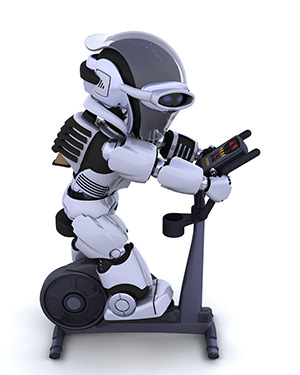
They come in two types: the upright and the recumbent. Upright exercise bikes are designed like traditional bikes with pedals that are partially aligned with the saddle. A recumbent exercise bike, on the other hand, has its pedals in front of the machine where the user has to recline to reach them. Exercise bikes can give huge bursts to the user’s heart rate, resulting in better calorie burn compared to the more fluid elliptical trainer. Like the later, an exercise bike is also a non-impact cardio machine, making it one of the safest to use.
Pros:
- The first and most important advantage is that it needs a little space for their storage because exercise bikes are small enough to be kept in any bedroom.
- Also, bikes require very little maintenance as they are powered by simple mechanisms. Cleaning the chain regularly and oiling the pedaling system are the only maintenance maneuvers that you need for proper functioning.
- Everyone can exercise on an exercise bike as cycling can be learned in only a few seconds.
- Stress on joints, ligaments, tendons and bones is less significant than in treadmill workouts, so the risk of injury is reduced.
- You can easily track your progress on the display, which can help you to keep the rhythm and burn more calories.
Cons:
- Exercise bikes only focus on muscle groups in the lower body so even if they have mobile arms, benefits for the upper body aren’t significant.
- The seats are often uncomfortable, and low back pain often occurs because of the position kept while working out. This concern applies to upright exercise bikes.
- Exercise bikes burn less calories than elliptical machines or treadmills.
Elliptical machines
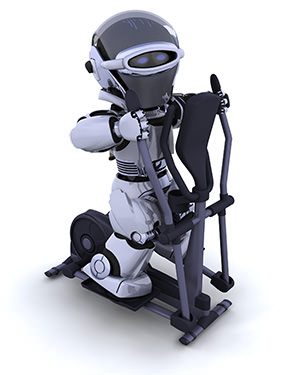
The elliptical trainer consists of a sturdy frame with incline ramps and comfortable side rails, non-slip pedals, drive belts and a powerful electric motor that runs the machine. It also features breaks, a pulley system and a console with controls and display.
The machine’s pedals move forward and backward, up and down, without touching the ground. And thanks to the fluid motion ensured by the electrical motor, movements are smooth enough to eliminate shocks and reduce stress exerted on spine and joints.
Higher-end elliptical machines have both movable and fixed handlebars, allowing you to target just lower body, or exercise both lower and upper body.
Pros:
- The elliptical machine features a wide range of programs for burning calories, building stamina and toning muscles.
- Exercising on elliptical will improve circulation, trimming down fats and improving resistance.
- Users can customize their workouts by selecting different speeds and resistance levels, by changing the incline and the rhythm of the workout.
- Low risk of injuries.
Cons:
- Elliptical machines are more expensive than bikes, steppers or rowing machines.
- Need more space for storage and are heavy because of the incorporated electric motor, so moving them from one room to another isn’t an easy task.
- Need regular maintenance, therefore, can be costly.
- Just like bikes and steppers, they focus on muscles in the legs, although they have features for working the upper body as well. Core muscles, hands, chest, and shoulders don’t really get an effective workout while using the elliptical machine.
- First movements need some effort for pushing the pedals forward so exercises can be tiring and difficult to perform for beginners.
Rowing machines
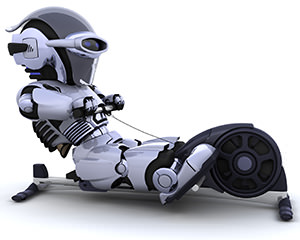
Forearms, biceps and triceps, shoulders and buttocks, abs and legs are all involved in movements performed on the rowing machine. That’s why it’s good not only for burning calories, but also for muscle definition.
Rowing machines can be:
- Air-powered, including a flywheel that exerts resistance when you pull the handle.
- Magnetic machines, using a break system for creating resistance.
- Piston-powered machines, which feature a pair of hydraulic pistons for resistance.
- Water resistance rowers, which use suspended paddles that spin in the closed water tank, move water and provide resistance.
Rowing workouts are considered low-impact, meaning that they don’t put too much pressure and stress on joints and spine. Regardless, they manage to burn an impressive amount of calories, the average value being around 450 calories for an 80kg adult working on the rower for an hour.
Rowing machines are composed of a resistant frame including:
- A sliding, padded and comfortable seat with an adjustable incline system.
- A central handle.
- An adjustable foot plate with a heel support system that enables you to adjust foot position while working out.
- A display, showing the speed, the time spent on rowing, the heart rate and the number of burned calories.
To get the maximum benefit from using a rowing machine, start with 5 minutes of warm up and then switch to the muscle building and calorie burning mode, adjusting position and speed as needed.
Pros:
- They provide a full-body workout as movements involve the core area, upper body, legs and buttocks at the same time.
- The exercises are simple to perform.
- Risk of injuries is reduced.
- Next to speeding up the heart rate, metabolism and calorie burning, rowing builds muscles and tones the entire body.
Cons:
- Workouts can become boring soon as there aren’t too many variations in movements.
- Rowing machines are usually heavy and need a lot of space for storage.
- Some of them can be noisy.
Stepper
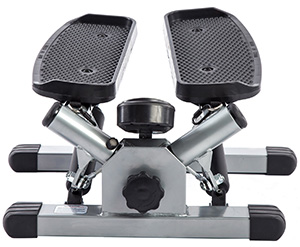
Step machines or steppers simulate the vertical movement of the legs when climbing stairs. Like the treadmill and the exercise bike, they target the lower body. The primary resistance of the stair climber is gravity, and body weight acts as the counterweight. Unlike other cardio exercise machines, vertical resistance is very stressed when climbing stairs, making it one of the most challenging cardio workouts.
Although exercising on this machine can be very tiring, those exercises can lead to larger calorie burn in a shorter period. The greater effort on the lower body muscles also mean that more muscles are being exercised using this machine, including those around the haunches and thighs. Unlike the exercise bike and the elliptical trainer, steppers are high impact and put pressure on the lower body. The extreme difficulty of vertical exercise also makes it a turn-off among beginners.
Pros:
- It works out the thighs, buttocks, and calves very efficiently.
- Burns more or less the same amount of calories as upright bikes.
- Steppers are lightweight and need a small space for storage.
- Usually are very cheap.
Cons:
- Only works muscles in legs, being inefficient when it comes to improving mass or toning the upper body.
- Steppers exert a lot of strain on joints in the knees, ankles, hips and spine, being less safe than exercise bikes.
- Workouts are pretty dull, and you need an impressive motivation to perform them regularly.
- Steppers aren’t stable enough for most people.
While there are many other aspects to consider when buying cardio equipment for your home gym, knowing these basics should help you to find out what is the best cardio machine for your needs and preferences.
 Best Home Gym Reviews and Tips for Your Home Gym
Best Home Gym Reviews and Tips for Your Home Gym
